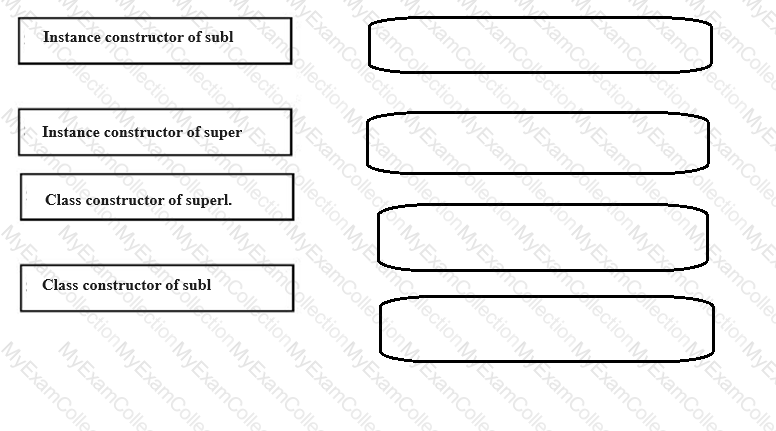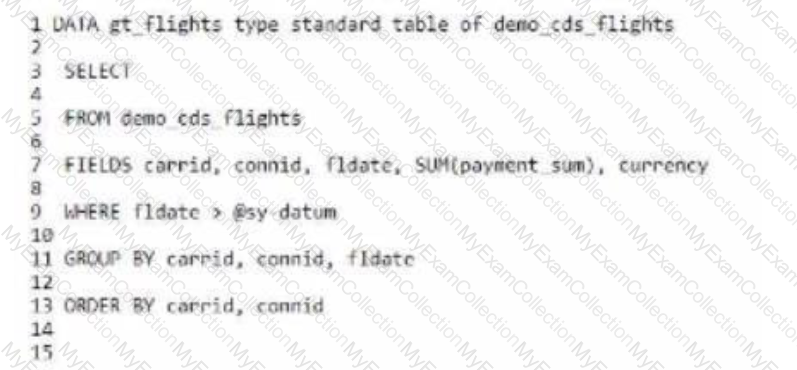target_itab = VALUE #( FOR row IN source_itab (
field1 = row-field1
field2 = row-field2
field3 = row-field3 )
).
Which of the following statements are correct? Note: There are 2 correct answers to this question.
In what order are objects created to generate a RESTful Application Programming application?
Which of the following integration frameworks have been released for ABAP cloud development? Note: There are 3 correct answers to this question.
You have a superclass superl and a subclass subl of superl. Each class has an instance constructor and a static constructor. The first statement of your program creates an instance of subl. In which sequence will the constructors be executed?

In a test method you call method cl_abap_unit_assert=>assert_equals( .. ) in the following way:
CLASS Itcl1 DEFINITION FOR TESTING RISK LEVEL HARMLESS DURATION SHORT.
PRIVATE SECTION.
METHODS m1 FOR TESTING.
ENDCLASS.
CLASS Itcl1 IMPLEMENTATION.
METHOD m1.
DATA: go_test_object TYPE REF TO zcl_to_be_tested.
CONSTANTS: Ico_exp TYPE string VALUE 'test2'.
CREATE OBJECT go_test_object.
cl_abap_unit_assert=>assert_equals(
EXPORTING
act = go_class->mv_attribute
exp = lco_exp
msg = 'assert equals failed ' && go_test_object->mv_attribute && ' ' && lco_exp
ENDMETHOD.
ENDCLASS.
What will happen if method parameters act and exp are not equal?
Which of the following are features of Core Data Services? Note: There are 3 correct answers to this question.
Which restrictions exist for ABAP SQL arithmetic expressions? Note: There are 2 correct answers to this question.
Class super has subclass sub. Which rules are valid for the sub constructor? Note: There are 2 correct answers to this question.
When processing an internal table with the statement LOOP AT itab... ENDLOOP, what system variable contains the current row number?
Which extensibility type does SAP recommend you use to enhance the existing UI for an SAP Fiori app?
You are designing the following select statement in ABAP Open SQL:

To adhere to the most recent ABAP SQL syntax conventions from SAP, on which line must you insert the "INTO TABLE @gt flights" clause to complete the SQL statement?
What RESTful Application Programming object contains only the fields required for a particular app?
What are some properties of database tables? Note: There are 2 correct answers to this question.
Given the following code,
DATA gv_text1 TYPE string. "#EC_NEEDED
DATA gv_text2 TYPE string ##NEEDED.
What are valid statements? Note: There are 2 correct answers to this question.
/DMO/I_Connection is a CDS view.
What variable type is connection full based on the following code? DATA connection full TYPE
/DMD/I_Connection.
In which products must you use the ABAP Cloud Development Model? Note: There are 2 correct answers to this question.
As a consultant you are posed the following question from a client who is using SAP S/4HANA Cloud,
public edition and also SAP BTP, ABAP environment.
"We are currently using an SAP Fiori app based on SAP Fiori elements that analyzes open orders. We
have determined that it should be extended via a new button on the UI which will perform an on-
the-fly calculation and display the result in a quick popup for the enduser. We have been informed by
SAP that all underlying stack layers for the SAP Fiori app have been extensibility enabled."
Based on this which of the following extension types would you recommend to the customer to add
the new button?
You want to provide a short description of the data definition for developers that will be attached to the database view

Which of the following annotations would do this if you inserted it on line #27


